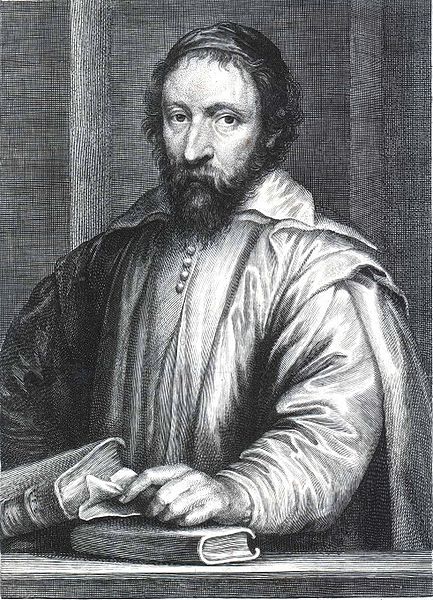<Back to Index>
- Astronomer Nicolas Claude Fabri de Peiresc, 1580
- Painter Karl Schmidt Rottluff, 1884
- Daimyo of Kai Province Takeda Shingen, 1521
PAGE SPONSOR

Nicolas-Claude Fabri de Peiresc (1 December 1580 – 24 June 1637) was a French astronomer, antiquary and savant who maintained a wide correspondence with scientists and was a successful organizer of scientific inquiry. His research included a determination of the difference in longitude of various locations in Europe, around the Mediterranean, and in North Africa.
His father was a higher magistrate and city surgeon in Provence from a wealthy noble family, who with his wife fled their home town of Aix - en - Provence to avoid the plague raging there, settling in Belgentier in Var. Peiresc was born in Belgentier and educated in Aix - en - Provence, Avignon, and at the Jesuit college at Tournon. At Toulon, he first became interested in astronomy. Studying law and becoming interested in archaeology, he travelled to Italy, Switzerland and France in 1599, and finally finished his legal studies in 1604 at the University of Montpellier. Also in 1604 he assumed the name Peiresc after a domain in Alpes - de - Haute - Provence (now spelled Peyresq) which he had inherited from his father, although he never went there.
After receiving his degree, he travelled to Paris (in 1605 - 1606, with his patron Guillaume du Vair, president of the Parlement of Provence), London and Flanders before returning to Aix in 1607 to take over his uncle's position as conseiller in the Parlement of Provence under du Vair until 1615. From 1615 – 1622, Peiresc again made a trip to Paris with du Vair. Later, he returned to Provence to serve as senator of sovereign court. He became a patron of science and art, studied fossils, and hosted the astronomer Gassendi from 1634 – 1637.
Peiresc's position as a great intellectual at the move from the Renaissance to modern science has led to his being called a "Prince of the republic of Letters". He was also a noted politician in his home region, and a tireless letter writer (10,000 letters by him survive), and he was in constant correspondence with Malherbe, Hugo Grotius, the brothers Dupuy, the brother of cardinal Richelieu, and with his great friend Rubens. His correspondence to Malherbe allows allows us a far better understanding of the personality of Malherbe's son Marc - Antoine Malherbe. Peiresc explains in one of these letter to Malherbe that Marc - Antoine is a bright student who craves and requires more attention from his indifferent father. But troublesome Marc - Antoine engaged other men in duels, one instance resulting in the death of Raymond Audebert, a bourgeois of Aix, in 1624. Malherbe had to use his political influence to keep his son from being arrested and decapitated. In 1627, Marc - Antoine died in a second duel against Paul de Fortia de Piles. This time, Malherbe used his influence to try to have Paul de Fortia arrested and executed for the death of Marc - Antoine, but to no avail as Paul de Fortia was protected by his future father - in - law, the affluent Jean Baptiste de Covet, Baron of Bormes, Trets and Marignane, who had played the role of Paul's second in the aforementioned duel. The drama of his son's death so saddened Malherbe that he died only 15 months after his son.
Peiresc's house in Aix - en - Provence was a true museum, and held a mix of antique sculptures, modern paintings, medals, books and gardens with exotic plants. As a collector, Peiresc acquired the Byzantine Barberini ivory (it is not known how or from whom) and offered it to Francesco Barberini - the work has been in the Louvre since 1899. He had the Codex Luxemburgensis, the surviving Carolingian copy of the Chronography of 354 in his possession for many years; after his death it disappeared. He owned over 18,000 coins and medals, and was also an archaeologist, amateur artist, historian (he demonstrated that Julius Caesar's invasion of Britain set out not from Calais but from St Omer), Egyptologist, botanist, zoologist (studying chameleons, crocodiles, the elephant and the alzaron, a sort of Nubian gazelle with a bull like head, now disappeared), physiologist, geographer (put on the project of linking Aix to Marseilles), and ecologist. He also wrote an "abridged history of Provence", though he died before editing it and is was posthumously published by Jacques Ferrier and Michel Feuillas in 1985 with Aubanel.
As well as all this, Peiresc was also an astronomer. In 1610 du Vair purchased a telescope, which Peiresc and Joseph Gaultier used for observing the skies, including Jupiter's moons; his courtly suggestion that individual names from the Medici family be applied to these "Medicean stars" was not taken up. Peiresc discovered the Orion Nebula in 1610; Gaultier became the second person to see it in the telescope. To determine longitude with greater precision, he coordinated the observation of the lunar eclipses of 28 August 1635 right across the Mediterranean; this allowed him to work out that the Mediterranean sea was in fact 1,000 km shorter than had previously been thought. Peiresc also wrote letters to Galileo, Pierre Gassendi and Tommaso Campanella, whom he defended when they were arrested by the Inquisition. With Gassendi's support, notably financially, he and the engraver Claude Mellan began to produce a map of the Moon's surface, but Peiresc died on 24 June 1637 in Aix - en - Provence before completing it.
A bronze bust of him has been set up on the square of the university in Aix - en - Provence, facing the cathedral of Saint Sauveur. His home near the palais de Justice was demolished to build the present Palais and has completely disappeared, although the village museum in Peyresq near Digne is wholly given over to his work and the asteroid 19226 Peiresc is named after him.